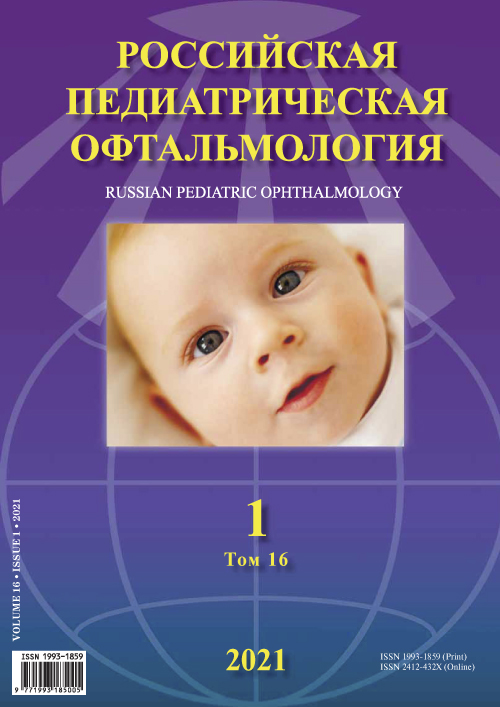Том 16, № 1 (2021)
- Год: 2021
- Статей: 6
- URL: https://bakhtiniada.ru/1993-1859/issue/view/4047
- DOI: https://doi.org/10.17816/rpoj.2021.16.1
Клинические исследования
Эффективность субтенонового введения триамцинолона для лечения макулярного отёка у детей с пигментным ретинитом
Аннотация
Цель: Изучить функциональные и анатомические результаты субтенонового введения триамцинолона детям с пигментным ретинитом (ПР) и кистовидным макулярным отёком (КМО), рефрактерным к местным ингибиторам карбоангидразы.
Материал и методы. Обследовано 11 детей (9 девочек, 2 мальчика) в возрасте от 9 до 17 лет, которым было выполнено субтеноновое введение триамцинолона (22 глаза). Срок наблюдения составил от 1,6 до 33,1 месяцев (в среднем 9,7±11,6 месяцев), количество введений – от 1 до 11 (в среднем – 3). До и после введения оценивались корригированная острота зрения (КОЗ), толщина и структура сетчатки в макулярной зоне с помощью оптической когерентной томографии (ОКТ) на приборах NIDEK RS-3000, Япония или Spectralis, Heidelberg Engineering, Германия), внутриглазное давление (ВГД).
Результаты. В конце периода наблюдения высота КМО уменьшилась по сравнению с исходной в 10 глазах (45,5%), при этом средняя центральная толщина сетчатки уменьшилась на 70–594 мкм (в среднем 219,1±183,4 мкм). Полная резорбция отёка произошла в двух глазах. В 12 глазах (54,5%) высота КМО существенно не изменилась. Острота зрения повысилась в двух глазах (9,1%) и не изменилась в остальных. У двух детей (18%) после двух введений триамцинолона в обоих глазах возникла офтальмогипертензия. У одного ребёнка ВГД нормализовалось на фоне гипотензивной терапии, у другого в связи с некомпенсацией ВГД на максимальном гипотензивном режиме в обоих глазах проведена синустрабекулэктомия, достигнута нормализация ВГД.
Заключение. Субтеноновое введение триамцинолона является достаточно эффективным и безопасным способом лечения КМО у детей с ПР. Лечение может быть рекомендовано при неэффективности ингибиторов карбоангидразы для уменьшения или резорбции отёка, сохранения или улучшения зрительных функций. Учитывая, что действие триамцинолона непродолжительно и требуется его повторное введение, а резорбция КМО у детей с ПР и повышение остроты зрения не всегда достижимы, необходимо продолжить поиск методов более эффективного лечения.
 5-12
5-12


Корреляционный анализ некоторых функциональных и анатомических параметров зрительного анализатора при нистагме и амблиопии различного генеза
Аннотация
Цель: Провести корреляционный анализ параметров зрительной фиксации, светочувствительности сетчатки в центральной области, толщины центральной области сетчатки и хориоидеи с максимально корригированной остротой зрения (МКОЗ), рефракцией (R) и аксиальной длиной глаза (ПЗО) при нистагме и амблиопии различного генеза.
Материал и методы. В исследование были включены 45 пациентов в возрасте от 5 до 44 лет (в среднем 11,2±6,14 года). Все пациенты были разделены на 6 групп в зависимости от вида амблиопии и сопутствующих состояний (при нистагме). Исследовали светочувствительность сетчатки и параметры фиксации на микропериметре MP-3 Nidek (Япония). Хориоретинальные параметры исследовали на спектральном оптическом когерентном томографе RS-3000 Advance 2 (Nidek, Япония). Аксиальную длину глаза измеряли при помощи Шаймпфлюг-анализатора Galilei G6. Корреляционный анализ проводили с использованием линейного коэффициента корреляции Пирсона (r).
Результаты. При нистагме, рефракционной и дисбинокулярной амблиопии выявлена сильная прямая корреляция между показателями МКОЗ и характеристиками фиксации. В группах, ассоциированных с врождённой близорукостью, выявлена взаимосвязь между МКОЗ, толщиной и светочувствительностью сетчатки в центральной области. Связь субфовеальной толщины хориоидеи с функциональными параметрами глаз отсутствовала.
Выводы. При нистагме и амблиопии, ассоциированной с косоглазием и гиперметропической рефракцией, первичным амблиогенным фактором является снижение плотности и амплитуды фиксации. При относительной амблиопии вследствие врождённой миопии снижение остроты зрения коррелирует со светочувствительностью сетчатки и не коррелирует с параметрами фиксации, что указывает на частично органическую природу относительной амблиопии. Не выявлено взаимосвязи толщины сосудистой оболочки со степенью амблиопии, что не подтверждает её участия в патогенезе заболевания.
 13-22
13-22


Клинические рекомендации
Птоз верхнего века. Диагностика, выбор хирургического лечения
Аннотация
В статье освещена актуальная проблема офтальмологии — птоз верхнего века, особенности диагностики, выбора хирургического лечения и послеоперационного ведения пациентов. Рассмотрены основные причины появления птоза верхнего века, описаны ключевые биометрические параметры век, позволяющие сделать патогенетически обоснованный выбор хирургического лечения. Освещены наиболее распространенные заболевания, приводящие к вторичному опущению века, или псевдоптозу, и способы их выявления.
 23-30
23-30


Клинические случаи
Лечение язвы роговицы и эндофтальмита, вызванных дрожжевыми грибами
Аннотация
Цель. Анализ патогенеза, клинических особенностей, алгоритма терапии грибковой язвы роговицы с эндофтальмитом для повышения врачебной настороженности и сокращения неоправданного применения антибактериальной и кортикостероидной терапии при заболеваниях роговицы различной этиологии, приводящей к развитию вторичных офтальмомикозов.
Результаты. Проведён анализ патогенеза, описаны характерные клинические симптомы тяжёлой грибковой язвы роговицы и эндофтальмита, вызванных Candida albicans. Интенсивная длительная неоправданная антибактериальная и кортикостероидная терапия вызвала затяжное течение герпетической язвы роговицы, присоединение вторичной бактериальной инфекции, развитие тяжёлой язвы роговицы и эндофтальмита грибковой этиологии у ребёнка 13 лет.
Заключение. Стремительное течение офтальмомикоза и ложноотрицательные результаты посевов содержимого конъюнктивального мешка влекут за собой неоправданное усиление антибактериальной терапии, рост частоты вторичной грибковой инфекции. В связи с этим требуется максимальная врачебная настороженность, ранняя и точная клиническая дифференциальная диагностика между бактериальной и грибковой язвой роговицы.
Описанные клинические симптомы тяжёлой грибковой язвы роговицы с эндофтальмитом способствуют ранней диагностике офтальмомикоза ещё до уточнения вида возбудителя лабораторными методами, что позволяет раньше начать противогрибковую терапию и избежать перфорации роговицы и потери глаза. В большинстве стран в связи с отсутствием глазной формы противогрибковых лекарственных средств для местного лечения кандидомикоза роговицы применяют в инстилляциях 0,2% раствор флуконазола, предназначенный для внутривенного введения.
 31-38
31-38


Клинические случаи лазериндуцированного повреждения макулы у детей
Аннотация
Цель. Изучить особенности клинико-функционального состояния глаз у детей после лазерного повреждения сетчатки.
Материал и методы. Обследовано 6 пациентов с фотоповреждениями сетчатки (9 глаз) после использования лазерной указки.
Результаты. Показано, что лазериндуцированное повреждение макулы привело к снижению зрения на 5 из 9 глазах, что коррелировало с изменениями показателей ритмической и макулярной электроретинограммы. Основным патогномоничным симптомом фотоповреждения макулы является наличие признаков локального разрушения пигментного эпителия и эллипсоидной зоны сетчатки по данным оптической когерентной томографии (ОКТ). В двух случаях после ожога макулы сформировалась неоваскулярная мембрана, что привело к необратимому снижению зрения.
Заключение. Бесконтрольное использование детьми бытовых лазерных приборов (указки) может приводить к выраженным нарушениям зрительных функций. По этой причине главным приоритетом должна быть профилактика, проведение активной санитарно-просветительской работы, информирование учителей, родителей и детей о потенциальном вреде использования лазерных приборов, своевременное выявление и лечение фотоповреждения сетчатки.
 39-46
39-46


 47-52
47-52








